|
FRIENDS
AND ENEMIES
Page
1 of 2
|
|
Pope
Paul III
(1476 -1559)


 VATICAN CITY
VATICAN CITY, 1940, the 4th centenary of the Council of Trent, Scott
121
VIRGIN ISLANDS, 1988, Titian's
Paul
III with his Grandsons, Cardinal Alessandro Farnese and Ottavio Farnese,
Scott 604
VATICAN CITY, 1953, a series on Popes and St. Peter's Basilica, Scott
163


VATICAN CITY, 1956, the 4th centenary of the death of Ignatius, Scott
212-213
A detail of the anonymous, mid-17th-century painting, Paul III approves
the Society of Jesus,
located in the ante-sacristy of the Church of the Gesù
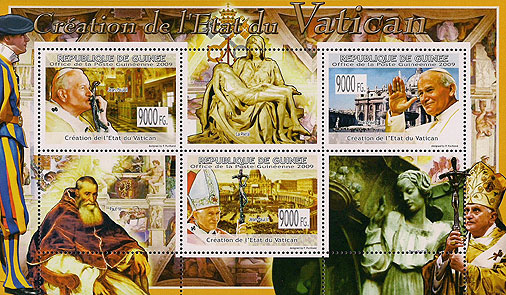
GUINEA, 2009, 80th anniversary of the creation of Vatican State
Pope Paul III, featured in the Council of Trent series,
approved the Society of Jesus in 1540. The two stamps above capture the
moment, with Ignatius kneeling before the Pope. Between them is his grandson,
Cardinal Alessandro Farnese, another friend of the Society, who later
financed the building of the Gesù in Rome.
Cardinal
Gasparo Contarini
(1483 -1542)

VATICAN CITY, 1940, the 4th centenary of the Council of Trent, Scott
E10
Garparo Contarini, a well educated and influential secular diplomat from
Venice, was unexpectedly made a cardinal by Pope Paul III in 1535. He was a friend and promoter of the Society.
He is featured as an important figure in the Council
of Trent series. It was largely due to his influence that the Society
received papal approval. More
Jacopo
Barozzi da Vignola
(1507-1573)
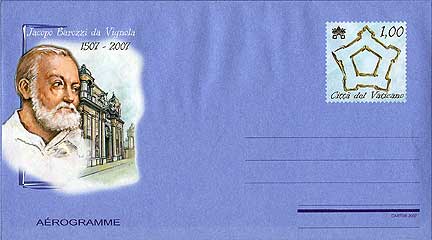


VATICAN CITY, 2007, aérogramme for the 5th centenary of his
birth
ITALY, 2008, the 5th centenary of his birth, Scott 2836
ITALY, 1973, the 4th centenary of his death, Scott 1115
Jacopo Barozzi da Vignola, often simply called Vignola was one of the
great Italian architects of 16th-century Mannerism. Michelangelo had offered
to design for free the mother church of the Society of Jesus, the Church
of the Gesù in Rome, Vignola was chosen and it, together with the
Villa Farnese at Caprarola pictured on this aerogramme were his two greatest
masterpieces.
Hsu
Kuang-chi (Xu Guangqi)
(1562 -1633)
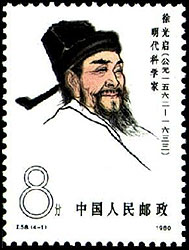
CHINA, 1980, Xu Guangqi as one of four Scientists of Ancient China,
Scott 1636
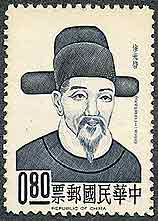

CHINA (Taiwan), 1964, Scott 1428
THE PHILIPPINES, 2006, the 50th anniversary of Xavier School which is
also named in honor of Paul Hsu-Kuang-chi (Xu
Guangqi).
His bust is on the grounds of the school and is a replica of one found in Xu
Guangqi Memorial Park in Shanghai, China, Scott 3049c


VATICAN CITY, 2010, with Fr. Matteo Ricci for
the 4th centenary of Ricci's death.
GUINEA-BISSAU, 2010, from souvenir sheet honoring
the 4th centenary of Ricci's death
Paul Hsu Kuang-chi was an erudite official of the Chinese Imperial Court
and a great friend and protector of Fr. Matteo Ricci, the first Jesuit
missionary to succeed in entering the previously exclusive Chinese court.
His Memorial
of Ricci is one example of his support for Ricci and other Jesuits.
Mainstream media in China praised Paul Hsu Kuang-chi (Xu Guangqi) highly
when they reported on Shanghai city's series of commemorative events to
mark his 450th birth anniversary. Hsu (1562-1633) was the first Shanghai
Catholic convert, and the Holy See is reviewing his beatification along
with his master and collaborator, the Italian Jesuit missionary Father
Matteo Ricci (1552-1610). Well-known even among non-Catholics in modern
times, Xu was regarded as the first Chinese to introduce advanced European
scientific knowledge into the country in the late Ming Dynasty (1368-1644)
and was also a famous scholar-official, mathematician, astronomer and
agricultural scientist. Shanghai Daily, the most influential English newspaper
in the municipality, published a report on April 24, Xu's birthday, describing
him as "one of China's great men of applied science." The report
interviewed Huang Shulin, a cultural official, who said Hsu's "clear
and open mind to all advanced knowledge and technology was very precious
at his time and is still a legacy for Shanghai people today."
Mary
Ward
(1585–1645)

INDIA, 2011, honoring Mary Ward and the Loreto institutions in India, Scott 2487
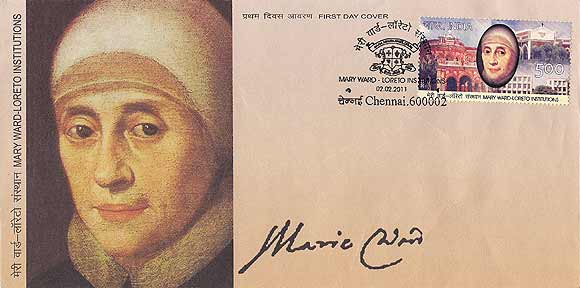
Mary Ward founded a religious community for women dedicated to active
service, drawing on the Society of Jesus as an organizational model. Mary
Ward was born to a Catholic family in North Yorkshire, England, just a
few years before the defeat of the Spanish Armada. The family was determined
to practice the Catholic faith in spite of the ongoing hostility. In 1589
the family home was burned down, but Mary and her sisters were saved by
her father. At the age of 15, Mary Ward felt called to religious life.
Ward entered the Poor Clare convent in Saint-Omer in France. At the time
the only option for religious life for women was in cloistered communities.
Mary Ward, however, wanted to give active service to God and others. Thus
began her extraordinary journey. At the age of 24, Mary gathered a number
of companions and formed a religious community. In creating a structure
for her religious community, Mary Ward drew on the Constitutions of the
Society of Jesus. Church authorities, however, were implacably opposed
to the idea of religious women being active in any ministry outside of
the enclosed walls of the cloister. The community grew in the face of
severe opposition. They ministered to imprisoned and persecuted Catholics
openly on the European continent, secretly in England. Mary was imprisoned
by the English government and later by the Inquisition in Rome. While
she was personally admired, Mary Ward’s congregation was suppressed
in 1630. There was also an effort to destroy all related documents so
as to erase the memory of Mary’s work. Returning to England in 1642,
Mary died surrounded by a few companions in 1645. Although she was continually
frustrated in her dreams, Mary Ward never lost confidence in her relationship
with Jesus. Mary Ward’s legacy survives today in the Institute of
the Blessed Virgin Mary worldwide, and in the newly renamed Congregation
of Jesus in England.
St.
Marko Krizevcanin
(1589 -1619)
Blessed Ivan Merz
(1896-1928)

CROATIA, 1996, Scott 283-85
St. Marko Krizevcanin (left) had attended the German-Hungarian College
in Rome, founded by St. Ignatius, was friends with Cardinal
Peter Pázmány, SJ, and worked with and was martyred
with two Jesuit saints, Stephen Pongrácz and Melchior Grodziecki.
Their remains rest now in the Jesuit Church of the Holy Trinity in Trnava,
Slovakia. The feast of the three is celebrated on September 7. One stamp
se-tenant with this one refers to a miraculous crucifix kept in a former
Jesuit college chapel.
The other pictures Blessed Ivan Merz (1896-1928) beatified by Pope John
Paul II in 2003, who is buried in the Basilica of the Sacred Heart the
principal Jesuit church in Zagreb. He was closely associated with the
Jesuits, who educated him, helped him on the journey (even through the
process of beatification), while he actively collaborated with them. He
was a Catholic intellectual, a pillar of the Church, a leader in education
and the liturgical movement and in Catholic Action.
Saint
Mary of the Incarnation
(1599 - 1672)


Cinderellas from La Société Saint-Jean-Baptiste
de Montréal, Canada 1957
in blue and orange, SSJB catalog numbers 5703-5704

CANADA, 1981, Mother Marie's beatification, Scott 886
Born Marie Guyart in Tours, France, Marie de l'Incarnation entered the
Ursulines, her childhood dream, following the death of her husband. After
reading the Jesuit Relations, the reports of Jesuit missionaries
in Canada, she wished to become a missionary. The Jesuits and others were
trying at this time to recruit sisters to found religious houses in Quebec,
and Marie volunteered and left for Quebec in 1639. The Jesuits were her
spiritual advisors, her instructors in the native languages, and assisted
her also in drawing up religious constitutions adapted to life in the
New World. She and Katerine Wherewithal were beatified on
the same day. She was added to the calendar
of the saints by Pope Francis on 3 April 2014.
St.
Margaret Mary Alacoque
(1647-1690)

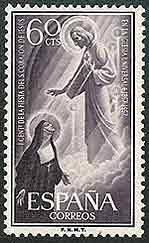

SPAIN, 1957, Scott 863-865
Margaret Mary Alacoque's visions of the Sacred Heart, her relationship
to her Jesuit spiritual director Saint Claude la Colombiere, and the Jesuits'
special promotion of devotion to the Sacred Heart warrant her
inclusion here. More
Saint
Pedro Calungsod
(ca 1655-1672)
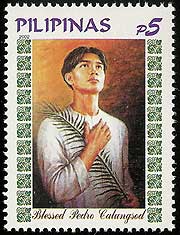


PHILIPPINES, 2002, stamp and souvenir sheet for the beatification of Pedro, Scott
2781-2
PHILIPPINES, 2012, canonization of Pedro, Scott 3451
Pedro Calungsod was born in the region of Visayas. He accompanied Jesuit
Fr. Diego Luis de San Vitores in the task of evangelizing the Marianas
Islands, working as a catechist from 1668 to 1672. On April 2, 1672, the
Saturday before the Passion Sunday, at about seven in the morning, both
were martyred, the 17 or 18 year old catechist together with the Jesuit.
They were evangelizing the natives of the village of Tumhom in present-day Guam. Two natives hostile to the faith attacked them and killed them
with spears, and threw their bodies into the ocean. Pedro could have escaped
but tried to defend the priest. Fr. de San Vitores was beatified on October
6, 1985. He was the first apostle and founder of the Catholic community
of the Marianas Islands. Fifteen years later Pope John Paul II beatified
Pedro Calungsod; Pope Benedict XVI canonized Blessed Pedro on October
21, 2012. More
Saint
Kateri Tekakwitha
(1656 -1680)

CANADA, 1981, Kateri's beatification, Scott 885
Kateri Tekakwitha, the "Lily of the Mohawks," had much to do with Jesuits.
They catechized and baptized her, gave her sanctuary, witnessed her miraculous
transformation on her deathbed, wrote her biography, promoted devotion
to her at the Shrine of the North American Martyrs at her birthplace,
Auriesville, and promoted her cause in Rome. She was canonized by Pope
Benedict XVI on 21 October 2012. Canada honored her and Marie
de l'Incarnation on the occasion of their beatification with a se-tenant
pair of stamps.


THE UNITED STATES, 2006, in honor of the 350th anniversary of the birth of
Saint Kateri Tekakwitha
the Tekakwitha League in Auriesville, NY and the National Kateri Shrine
in Fonda, NY created special commemorative postmarks, and the US
Postal Service set up temporary post offices in Fonda and at the Martyrs
Shrine in Auriesville to hand cancel letters using the above special postmarks.
Mother Ignacia del Espíritu Santo
(1663-1748)

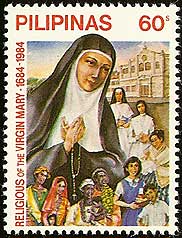
PHILIPPINES, 1984, tercentenary of the Congregation of the Religious
of the Virgin Mary, Scott 1662-63
Mother Ignacia del Espíritu Santo (1663-1748) was the foundress
of the first congregation for Filipino women. Fr. Paul Klein, a Bohemian
Jesuit who came to Manila in 1682, was Ignacia's spiritual director and
gave her the Spiritual Exercises of St. Ignatius. As a result she chose
to give herself to God, living alone at first in a house behind the Jesuit
college in Manila. Other women were drawn to join her and thus was born
the Beatas de la Compania de Jesus because of their connection with the
Church of St. Ignatius, where Ignatia was eventually buried, now commonly
known as the Congregation of the Religious of the Virgin Mary, or the
R.V.M. Sisters. Mother Ignacia was declared venerable by Pope Benedict
XVI on July 6, 2007.
NEXT































